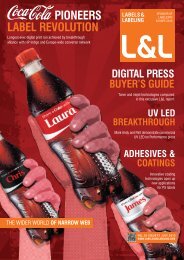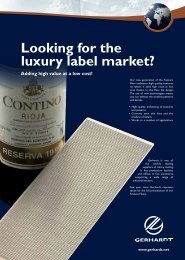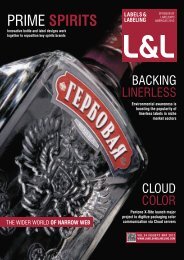SELL
Download - Labels & Labeling
Download - Labels & Labeling
- No tags were found...
Create successful ePaper yourself
Turn your PDF publications into a flip-book with our unique Google optimized e-Paper software.
38 | L&L<br />
specific application so that you can work with a supplier to provide a<br />
recommendation that meets all of those needs. Take into account that<br />
suppliers will need exact regulatory requirement numbers to make an<br />
informed recommendation. As always, it is important to test adhesive<br />
options within the specific application to ensure regulations are met.<br />
No6.<br />
HOW<br />
two categories, shelf life and durability. Shelf life<br />
LONG WILL A LABEL LAST?<br />
Label life expectancy can be broken into<br />
refers to the amount of time a label maintains its quality and performance<br />
level in an unapplied state. To maximize shelf life, raw material label<br />
stock and finished labels should be stored in conditions as close to 72<br />
F and 50 percent RH as possible. Durability relates to how long a label<br />
will perform on a substrate in its end- use application. Label durability<br />
depends on label construction, print technology and environmental<br />
conditions. Understanding the durability needs for an application is key to<br />
designing a cost-effective and successful label solution.<br />
No7.<br />
WHEN DO I NEED A DIRECT VS.<br />
INDIRECT FOOD CONTACT ADHESIVE<br />
FOR MY APPLICATION?<br />
The main factor that determines whether food contact labeling is<br />
considered direct or indirect revolves around whether there’s a functional<br />
barrier between the food that is being labeled and the adhesive. For<br />
more specific information, please refer to the Food and Drug Administration’s<br />
mandates on the topic: FDA spec 21 CFR 175.105 for regulations<br />
on indirect food contact adhesives and FDA spec 21 CFR 175.125 for<br />
direct food contact adhesives. Also remember that with food labeling<br />
there can be additional regulations that relate to the label facestock,<br />
inks, varnishes, etc, further highlighting the importance of working with<br />
knowledgeable suppliers.<br />
No8.<br />
WHAT FILM FACESTOCK SHOULD I USE?<br />
There are numerous types of film facestocks to<br />
choose from that could fit the needs of labeling<br />
applications, and all have their own unique characteristics that may help<br />
or hinder performance. Knowing these performance characteristics<br />
are only part of the equation, however, as you’ll also need to know the<br />
facestock’s converting characteristics, such as usefulness for printing,<br />
die cutting and so on. The most popular film facestocks used in prime<br />
labeling are biaxially-oriented polypropylene (BOPP/PP) or polyolefin<br />
(PO), polystyrene (PS), and polyethylene (PE). For more durable labeling<br />
requirements, polyvinyl chloride (PVC) and polyethylene terephthalate<br />
(PET) are often used. For those customers that would like a more<br />
environmentally friendly facestock, polylactic acid (PLA) has become<br />
quite popular. The usual rules apply when it comes to selecting a<br />
film facestock: know your application needs and select a face stock<br />
accordingly.<br />
No9.<br />
WHAT ADVICE CAN YOU GIVE<br />
REGARDING DIGITAL PRINTING ON<br />
PRESSURE SENSITIVE LAMINATES?<br />
When planning the best method for digitally printing labels, research<br />
what products are recommended for your digital press or printer model<br />
for optimal results. Knowing what model you or your customer is using,<br />
required properties of printing materials (such as basis weight and caliper<br />
range), the printer or press’s media handling capabilities (whether it can<br />
handle pressure-sensitive label media), and whether the printer requires<br />
ink-specific stock (ink jet, toner, thermal transfer, Indigo, etc.) is very<br />
helpful when making printing decisions. For any pre-print requirements,<br />
check with your ink manufacturer to find out whether a given ink will work<br />
well on certain substrates and be functional and safe for use in that digital<br />
press or printer. As a result, it is safest to steer toward products made<br />
specifically for digital printers.<br />
When working with thermal transfer printers, finding the right ribbon<br />
to use is imperative. In general, wax-resin ribbon should be trialed on<br />
substrates not originally designed for thermal printing. Testing all aspects<br />
of the printing and end-use for a product is the only way to be sure that<br />
your label construction and design will effectively meet your customer’s<br />
expectations.
















